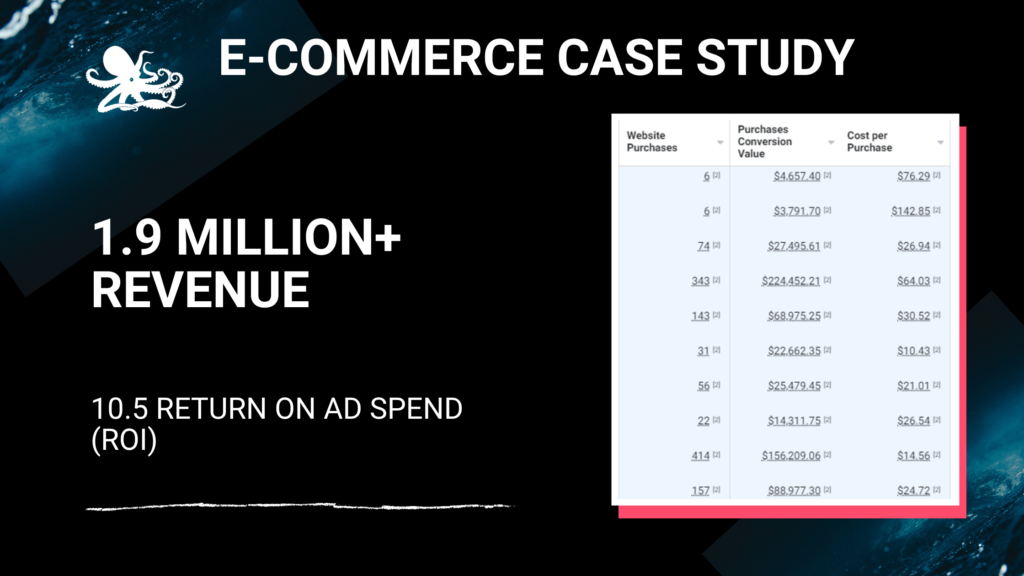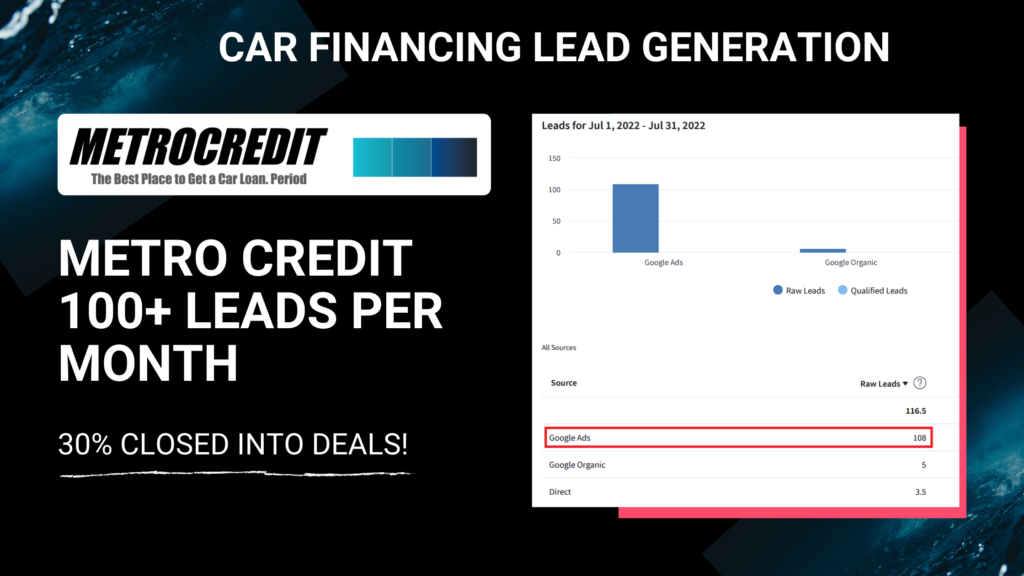
Our client ran a startup Ecommerce business that has an average order value of over $700. They previously hadn’t run Facebook or Instagram ads.
(In the marketing agency business, we colloquially refer to all Meta–Facebook & Instagram ad–placements as “Facebook Ads.”)
They had been in business for less than six months, and had a compelling product that customers loved, were competitively positioned, and had a high demand during COVID consumer online shopping trends.
They had a strong Instagram page with high engagement. Our client also had strong PR, having their product published and reviewed in major, mainstream publications. This drove the majority of their sales.
They were referred to Black Octopus Agency by a prior client, who knew we had a strong digital marketing expertise and running and scaling Ecommerce Facebook Ad campaigns.
They were looking to rapidly grow, currently they were doing $30,000 to $100,000 in sales per month. Their target was hitting $500,000 in sales per month, or more.
They had consulted a number of other service providers, Facebook ads freelancers and other digital marketing agencies.
However, based on our past results, strong industry knowledge and detailed roadmap in our proposal for scaling their business, they chose to hire Black Octopus. We were also highly agile given their aggressive growth plans, with multiple weekly marketing meetings to assess how well the ads were doing, test new creatives the client provided us, and report on results.
Within one year we were able to scale them up to over $630,000 in sales per month, with over 80% of the revenue being new customers from our Google, Facebook and Instagram ad campaigns.

The first thing we do at Black Octopus before ever working with a client is getting a deep understanding of their business. Some questions we always ask before ever engaging in a digital marketing campaign are:
Armed with more knowledge, we put together a proposal and strategic goals for our marketing and ad campaigns.
For most Ecommerce business clients, Facebook & instagram ads are the best, most effective way to drive sales. They already had a strong presence on social media. We assessed this as the best advertising channel to pursue initially.
One of the biggest wins this client had before spending a dollar on Facebook ads was that they already had the Facebook pixel installed. This meant that every single purchase since they launched their Shopify store was captured on the Facebook ads platform.
This meant we could feed that data back into Facebook to match their customer information with their advertiser profile.
Also, this provides Facebook valuable data on who purchases, and just as importantly, who doesn’t.
This varies from demographic, geographical data, to user behavior, pages they like, what browser and device they’re on, to how long they spent on the site and how engaged they were.

Another powerful feature of the Facebook Ads Manager is that you can upload CSV files to create Custom Audiences. These lists can be generated from anywhere, for this client they were exported from Shopify.
We uploaded a list of all their past customers. For Facebook custom audiences to match them to a social profile, the data needs to include an email.
This allowed us to create retargeting campaigns. These campaigns targeted all past customers with a cross-sell offer. Since they had purchased from our client’s website before, it’s much more likely they’ll purchase again versus a cold audience.
Most importantly, custom audiences allow you to create powerful lookalike audiences.
One of the most powerful, most profitable features of Facebook ads that set it apart from other ad platforms like Snapchat and Tiktok ads are lookalike audiences.
This takes a dataset (such as a custom audience, or pulled from people who have engaged with your Instagram or Facebook page) and creates an entirely new set of people to advertise to.
Facebook looks at your list (use a list of 1000 or more people) and determines all the characteristics of their online activity and finds what commonalities they have.
From here, it generates a much larger list (you can select sizes of 1 million, 2 million, 3 million up to 10 million) of people on the platform who aren’t your past customers, but share traits in common with them.
This lets you target entirely new people, who haven’t bought, but are probably likely to. This is an extremely powerful, common strategy with running effective ad campaigns.
Using lookalike audience targeting, with narrowed sub-interest targeting (narrowing by if they liked or engaged with certain topics) we were able to get between 10 and 40 times return on ad spend. (For every $1 spent, the ads generated up to $42 in sales).
Given that our client had a 60% cost of goods sold margin, the ads were highly profitable.
The client immediately wanted to reinvest their profits back into their ad campaigns. However, they were dealing with oversea supply chain issues along with the rest of the world.
Their product was sold out, and pre-sold out frequently during when we were running the ad campaigns.
The only limit to their growth was having enough stock to meet demand–a factor outside of our control.
Once they had solved their supply chain issues, they were eager to scale their adspend.
One thing that is common with running ad campaigns, is ROAS (return on ad spend) typically drops at scale. This is because the amount of people who are highly likely to convert into a purchase goes down as you reach large numbers and economy of scale. Revenue will increase drastically, however the ad spend return lowers.
However, the ads were still highly profitable and maintained 10-20 times ROAS. Imagine in the investment world if you could get a return of 10-20x, it would be a no-brainer.
We were able to go from spending $5000 on Facebook Ads per month up to $40,000 while maintaining profitably, and driving incredible revenue numbers. At the peak of their ad campaigns, Facebook was generating over $200,000 a month in sales.

While Facebook ads are typically the best platform for ecommerce paid ads, paid search (Google) or CPC ads can be another valuable ads channel. We wouldn’t suggest running Google Ads for lower ticket Ecommerce businesses, as the ad costs are high, but since this client had a high ticket product we were confident it could be a successful channel.
Our Google Ads specialists started with a monthly budget of $5000 in ad spend. They targeted highly specific keywords such as “buy [keyword] online” or “best [keyword]” that indicated high purchase intent and that they were bottom-of-the-funnel–about to make a purchasing decision.
We used phrase match keywords, so our ads would only show to slight variations of the keyword we targeted to avoid irrelevant searches. Also based on our experience, since it was a high ticket product we used negative keywords to avoid unqualified traffic, such as “cheap,” which meant ads wouldn’t show to those searches. Likely those people would be put off by the price point.
Google and Facebook ads bill your ad spend entirely differently. Facebook charges per 1000 impressions (CPM), while Google charges you per click (CPC – cost per click).
That means we wanted to avoid any unnecessary or unqualified clicks and find those most likely to convert, so our ads could be as profitable as possible.
As part of regular Google ads account maintenance, for the entire duration of the campaign we regularly add negative keywords to our list as new searches (found in the Search Term Report) come in.
This keeps the campaign performing well and decreases your CPA and is a standard industry practice. This is just one small reason you should hire a marketing agency to handle your Google ad campaigns.
Within the first month we were able to get exceptional results. From a 30 day budget of $5000 we were able to generate over $80,000 in sales, with a return on ad spend of 18x.
Seeing this as a fantastic channel for getting sales and new customers, the client invested in scaling up their Google Ads.
Over the next 6 months we scaled the Google ad spend up to over $30,000 and maintained a ROAS of 8-10.
What is a good ROAS?
While it varies from industry to industry, and depends on your product margins, obviously the higher the better.
There are many factors that can impact your ROAS, such as:
That being said, most agencies consider 4x ROAS and above a good number and a measure of effective marketing.
Black Octopus Agency ROAS
We simply blew this industry benchmark out of the water. Our client was extremely happy with the results and made a huge amount of profit based on our digital marketing strategy. We maintained 10-20x ROAS at scale, and over 40x ROAS on a smaller ad budget in the beginning.

Metro Credit is a car financing company located in Bedford, Nova Scotia. They also have an affiliated company that sells vehicles that they refer financing leads to for car sales.
They primarily serve the Halifax region but service clients all across Atlantic and Eastern Canada.
Previously they generated all of their leads organically, from local referrals, as well as paying per lead from car lead generation companies.
They were looking for another lead channel, and wanted a reliable source of qualified leads at a profitable cost.
Their average client lifetime value (LTV) is worth about $3,000 from fees collected from financing car loans.
They would purchase pre-qualified leads from a company at a cost of $150 per lead. This company would generate leads through primarily cold phone calls.